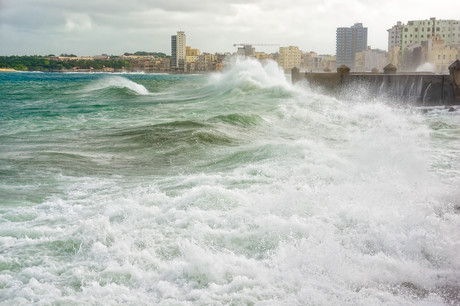Storm chasers — predicting the future of coastal flooding

Cyclones and their storm surges are a costly and deadly reality for the vast number of people living and working in coastal areas. According to the Bureau of Meteorology, the combination of strong onshore winds and low atmospheric pressure associated with storms can create a pronounced increase in the sea level. This is often called a storm surge. Potentially, storm surges are the most destructive phenomenon associated with tropical cyclones.
Simulating storm surges is challenging and important. Being able to predict storm surges could help mitigate flood risks in low-lying coastal regions.
Surges are sensitive to a number of factors, including atmospheric wind speeds and pressures. Scientists found that accurate models of storm surges could be built by taking advantage of high-resolution regional simulations of tropical cyclones.
Using high-resolution regional atmospheric models to improve tropical cyclone simulations may allow for more accurate predictions of storm surges in the ocean below.
Simulating tropical cyclone winds is challenging because they are sensitive to moist atmospheric processes such as cloud microphysics and convection, which are hard to model.
In a recent study, funded by the US Department of Energy as part of the Integrated Assessment Research program, researchers evaluated the uncertainty in simulating cyclonic winds and pressures using high-resolution regional models. They compared local simulations with different representations of clouds and convection against observed atmospheric data for Hurricane Katrina.
They also used simulated winds and pressures from the high-resolution atmospheric model to predict Hurricane Katrina’s storm surge in the northern Gulf of Mexico. They evaluated the storm surge simulations using high-water marks collected by the Federal Emergency Management Agency along the Alabama, Mississippi and Louisiana coasts.
Results showed that regional simulations of Hurricane Katrina are sensitive to the atmospheric model’s approximations of both convection and cloud microphysical processes. These processes are linked to cyclone development and intensification.
The findings demonstrate the value of simulating storm surge and inundation using high-resolution regional simulations of cyclonic winds and pressure. The results could also help improve understanding of coastal flooding vulnerabilities and risks.
Could this tailored heart pump transform care for half of heart failure patients?
Half of the 64 million people living with heart failure have no access to heart pump treatments....
Breastfeeding challenges healthcare professionals should be prepared to address
A neonatal nurse and lactation consultant sets out what she sees as the most common breastfeeding...
Framework seeks to cut medicine errors at transitions of care
The first coordinated, hospital-based approach to medication management at transitions of care...




![[New Zealand] Transform from Security Awareness to a Security Culture: A Vital Shift for SMB Healthcare — Webinar](https://d1v1e13ebw3o15.cloudfront.net/data/89856/wfmedia_thumb/..jpg)
![[Australia] Transform from Security Awareness to a Security Culture: A Vital Shift for SMB Healthcare — Webinar](https://d1v1e13ebw3o15.cloudfront.net/data/89855/wfmedia_thumb/..jpg)




